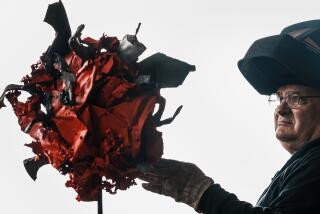Photographer, First on Scene at Chernobyl, Opens Exhibit
- Share via
BALTIMORE — The Ferris wheel at an amusement park turns riderless in the wind. And the eyes of children stare unknowingly at a cameraman whose free hand holds a Geiger counter registering off the scale.
Visitors to the photo exhibit of Igor Kostin, the first Soviet photographer on the scene of the April 26, 1986, explosion at the Chernobyl power plant, are greeted by the images of burn victims, rescue workers and the contaminated rubble. It is a testament to the world’s worst nuclear accident.
“This is definitely not art,” said Kostin, a 53-year-old industrial designer turned photographer. “It can’t be a piece of art because it was such a terrible thing. It’s a historical tragedy for our people and a warning for other people that this could happen anywhere.”
Kostin was in Baltimore to kick off the U.S. tour of his exhibit, “Chernobyl: Not to Be Forgotten.”
About 100 black and white and color photos are arranged in chronological order, beginning with the destroyed building of Reactor 4, the arrival of rescue workers and nuclear power officials and the cleanup operation, and ending with more recent photos of the Chernobyl trial, protests in Kiev, residents who either have refused to leave the 18-mile danger zone or are awaiting government relocation, and deformed animals and contaminated crops in the area.
The exhibit ends with a brief photocopied statement from Kostin: “When I think back, it seems as if it were yesterday. I can hear the noise of the helicopter and I can see the people who had to leave their homes taking with them only a cat or a kitchen pot as they fled from the danger. Then I think, ‘Did it all really happen?’ ”
Kostin, who lives in Kiev, about 60 miles from the plant, continues to return to the danger zone despite the health risk.
“I went there the first time because I just had to see with my own eyes, and I took my camera so other people could see,” said Kostin, a photographer with the Soviet news agency Novosti. “I go back now because it is a magnet drawing me. Someone has to continue to go back into the affected area, to show the world that there are still people living there, to show that it never should have happened and that it must never happen again.”
Kostin said the government has been cooperative in allowing him to show the photographs and to travel with the exhibit.
“Five years ago I couldn’t even think about this,” he said. “I’m happy to live at a time when I can show what I’ve done and can tell what I have to tell.”
Proceeds from the exhibit, which has a $1 entry fee, will help establish the Igor Kostin Fund for Children of Chernobyl, said Susu Erca of the Italian firm sponsoring the exhibit. The fund will go toward medical supplies for hospitals within the danger zone.
More to Read
Sign up for Essential California
The most important California stories and recommendations in your inbox every morning.
You may occasionally receive promotional content from the Los Angeles Times.













